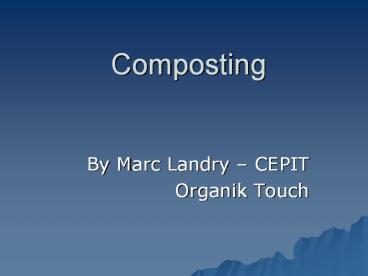Composting PowerPoint PPT Presentation
1 / 25
Title: Composting
1
Composting
- By Marc Landry CEPIT
- Organik Touch
2
- Organik Touch
- We specialize in organic fertilizers,
landscaping, lawn maintenance, horticulture and
alternative solutions for gardening - We also offer landscape design, consultation,
project management and conferences - We offer biodegradable, phosphate free household
cleaners
3
Quick facts
- The Department of Environment estimates that for
every ton of organic material diverted from the
landfill, there is a reduction of 15 tons of CO2
equivalent - A Feasibility Study completed for the NSWC in
2007 estimates that over 5000 tons of organics
are sent to the landfill from Northumberland
County each year.
4
(No Transcript)
5
Basics of composting
- Simple process of nature.
- No need for specialized equipment or special
knowledge - We need to know how to separate the ingredients
(greens and browns) - Trial and errors
6
How composting works
- In nature, organic wastes are broken down
- through a combination of biological and
- chemical processes. Biological agents like
- worms, insects, fungi, bacteria and other
- micro-organisms "chew up" the materials,
- which are further transformed by oxidation
- (exposure to air), reduction and hydrolysis
- (exposure to water).
7
Successful composting
- The right amount of water and air to keep the
biological and chemical processes functioning. - The right temperature. For the purposes of
composting, the warmer it gets, the better. In a
cool environment, the composting process slows
down. - The right CN ratio. This ratio will affect the
speed of decomposition. Ideally, your CN ratio
should be thirty to one.. - The right container. You can build your own or
buy one from your local hardware store or garden
supply centre.
8
Keys to success
- Air
- Humidity
- Turning
- Material (size and mixture)
9
Building a composter
- Building your own composter will allow you to
design a unit to suit your specific needs. - A composter can be made of wood, concrete blocks,
wire mesh or almost any material you have
available.
10
Key features in a composter
- A lid that protects the pile from rain and snow
and allows you to control how much moisture gets
in. - Holes or vents to allow air circulation.
- A means of removing the final product.
- Access for turning the pile
11
(No Transcript)
12
(No Transcript)
13
Vermi composting the basics
- Red worms are simply the best method of
composting kitchen waste - designed over millions of years into the fastest
natural composters. - They will happily turn kitchen waste into compost
or vermicompost. - The castings are thick, dark, nutrient rich
compost that will result in increased garden
yields and indoor plants to thrive.
14
- Worm composting, or vermiculture, requires very
little work, produces no offensive odors, and
helps plants thrive. - You can compost vegetable scraps, fruit peelings,
bread and grains, tea bags, coffee grounds and
filters and well-crushed eggshells. Do not
compost meat, bones, fats, dairy products, salt
and vinegar. - Your red worm can consume 2 to 3 pounds of waste
for ½ pound of worms and 3 to 5 pounds for a
pound of worms over 10 days.
15
(No Transcript)
16
Compost recipe
- You can use the simple rule that compost needs to
be about 2 "brown" and 1 "green" - Learn to C/N ratio to balance the recipe
17
- Algae
- Bone meal
- Coffee grounds
- Eggshells
- Feathers
- Flowers
- Fruit and fruit peels
- Grass clippings (fresh)
- Hair
- Manure
- Seaweed
- Tea Leaves
- Vegetables and peelings
- Weeds
18
C N Ratio - GREENS
19
- Buckwheat hulls
- Coffee filters
- Corn cobs
- Cotton/wool/silk scraps
- Grass clippings (dried)
- Hay
- Leaves (dead)
- Paper
- Peat moss
- Pine needles
- Sawdust
- Straw
- Tea bags
- Wood chips
- Wood ash
20
C N Ratios - Brown
21
- Pet wastes
- meat, fish, fats and dairy products
- insect-infested or diseased plants
- Materials contaminated by synthetic chemicals or
treated with herbicides or insecticides - Weeds with mature seeds, and plants with a
persistent root system - Leaves of rhubarb, oak and walnut contain
substances toxic to insects or other plants - Painted products
- Contaminated ashes
- Bio medical waste
22
Building a compost pile
- Gather both "green" and "brown" ingredients,
enough to make a compost pile measuring at least
1 meter (3 feet) in each direction (high, wide
and long). - Chop or shred into small pieces as much of the
material as possible - Layer 15 cm (6 inches) of well-watered "browns"
and 7.5 cm (3 inches) of "greens," mixing the two
layers together.
23
Troubleshooting
- Smell
- An earthy scent is normal and inoffensive, but a
well-built compost shouldn't produce unpleasant
odors. - If it does, your problem is either too much
"green" stuff (ammonia smell) or too little air
(rotten-egg smell). - First, aerate the pile. If the odor persists,
turn and rebuild the pile with more "brown"
materials. - What if the compost pile doesn't heat up?
- The odds are that an inactive compost pile just
doesn't have enough "greens" or - The pile is too small
- Check if the pile is moist
24
Benefits of compost
- It helps hold moisture in the soil making your
plants more drought-tolerant. - Compost releases nutrients slowly when your plant
needs them. - Compost adds macronutrients (nitrogen,
phosphorous and potassium) and micronutrients
(calcium, magnesium and boron) to the soil. - Compost allows your plants to become healthier
and stronger. The result is that they are much
more resistant to disease and pest problems.
25
- Thank you!
- Organik Touch595 Woodland Dr EastNorth
Tetagouche, NBE2A 4Z1Tel 506 545 6505 Fax 506
545 6504www.organik.nb.catouche.organik_at_nb.aibn.
com - In collaboration with

